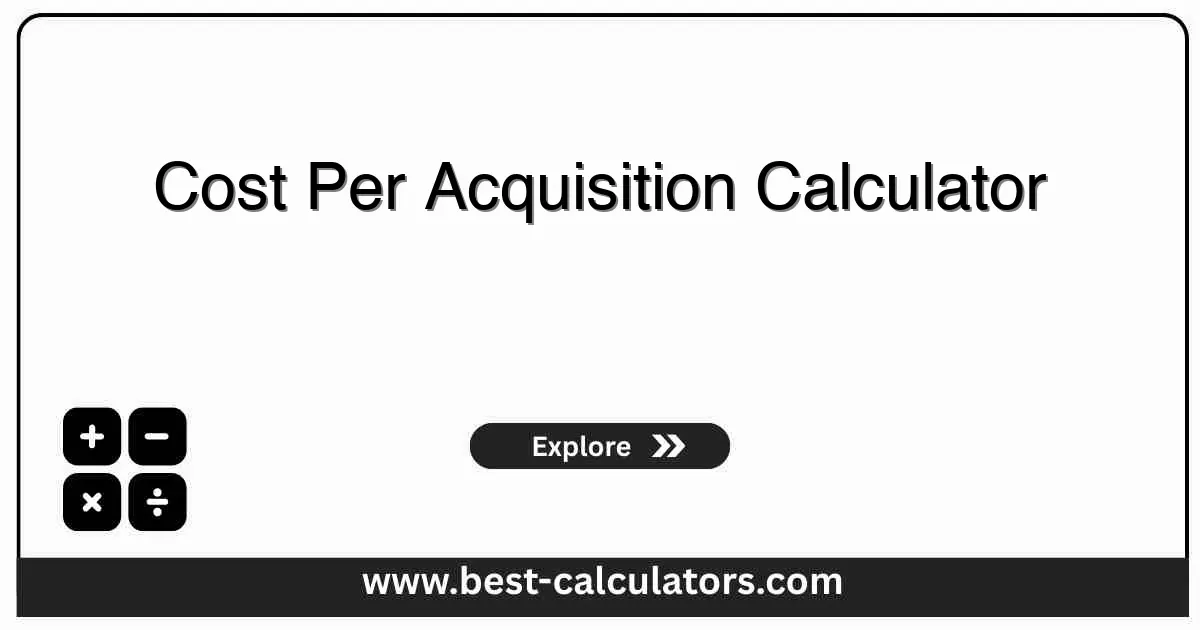Cost Per Acquisition Calculator - Calculate CPA and Marketing Efficiency
Free calculator to measure customer acquisition costs, CPA, cost per lead, and marketing efficiency for your business
Cost Per Acquisition Calculator
Results
What is Cost Per Acquisition (CPA)?
Cost Per Acquisition (CPA) is a critical marketing metric that measures the total cost of acquiring a new customer. It represents the total marketing and sales expenses divided by the number of customers acquired during a specific time period.
This calculator works for:
- Digital Marketing - Calculate ROI from online advertising campaigns
- Sales Teams - Measure sales team efficiency and cost-effectiveness
- Content Marketing - Evaluate content marketing customer acquisition costs
- E-commerce - Track customer acquisition costs for online stores
- Service Businesses - Calculate client acquisition costs for service providers
To complement your CPA analysis and understand long-term customer value, you can calculate your Customer Lifetime Value using our Customer Lifetime Value Calculator.
For optimizing sales team performance and compensation, explore our Sales Commission Calculator to determine effective commission structures.
To assess overall profitability alongside acquisition costs, try our Gross Margin Calculator for comprehensive financial insights.
How CPA Calculator Works
The calculator uses proven marketing metrics formulas:
CPL = Total Marketing Costs ÷ Leads Generated
Conversion Rate = (Customers ÷ Leads) × 100
Where:
- CPA = Cost Per Acquisition (main metric)
- CPL = Cost Per Lead (early-stage metric)
- Conversion Rate = Lead-to-customer conversion percentage
- LTV = Customer Lifetime Value for comparison
Key CPA Concepts Explained
Cost Per Acquisition
Total cost to acquire one paying customer
Cost Per Lead
Cost to generate one marketing lead
How to Use This Calculator
Enter Marketing Spend
Input your total marketing budget for the period
Add Lead Count
Enter number of marketing leads generated
Input Customer Count
Enter number of customers acquired
Get CPA Results
View CPA, efficiency score, and key metrics
Benefits of Using CPA Calculator
- • Marketing ROI Analysis: Understand which marketing channels deliver the best customer acquisition value.
- • Budget Optimization: Identify the most cost-effective customer acquisition strategies.
- • Performance Benchmarking: Compare CPA across different campaigns, channels, and time periods.
- • Strategic Planning: Make data-driven decisions about marketing spend and resource allocation.
Factors That Affect Your CPA
1. Marketing Channel Selection
Different channels have vastly different CPAs - social media advertising typically has lower CPA than traditional media
2. Target Audience Quality
Better targeting leads to higher-quality leads and lower CPA through improved conversion rates
3. Sales Funnel Efficiency
A well-optimized sales process reduces the cost to convert leads into paying customers

Frequently Asked Questions (FAQ)
Q: What is Cost Per Acquisition (CPA)?
A: Cost Per Acquisition (CPA) is a marketing metric that measures the total cost of acquiring a new customer. It includes all marketing and sales expenses divided by the number of customers acquired during a specific time period. CPA helps businesses understand their customer acquisition efficiency and marketing ROI.
Q: How is CPA calculated?
A: CPA is calculated using the formula: CPA = Total Marketing Costs ÷ Number of Customers Acquired. This includes all advertising expenses, marketing campaigns, sales team costs, and other customer acquisition expenses divided by the number of new customers gained.
Q: What's the difference between CPA and CPL?
A: CPA (Cost Per Acquisition) measures the cost to acquire a paying customer, while CPL (Cost Per Lead) measures the cost to generate a marketing lead. CPL is an earlier stage metric that doesn't account for conversion rates from lead to customer. CPA provides a more complete picture of customer acquisition efficiency.
Q: How can I lower my CPA?
A: To lower your CPA, focus on improving targeting to reach more qualified prospects, optimize marketing campaigns for better conversion rates, streamline the sales process, improve lead quality, and consider referral or content marketing strategies that have lower acquisition costs.
Q: What is a good CPA?
A: A good CPA varies by industry and business model. Generally, a lower CPA is better, but it should be compared to customer lifetime value (LTV). A good rule of thumb is that CPA should be less than 1/3 of LTV to ensure profitability. For example, if your average customer is worth $300 in their lifetime, your CPA should ideally be under $100.